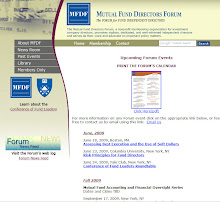SAB No. 111 is intended "to provide guidance for assessing whether an impairment of a debt security is other than temporary, as well as how such impairments are presented and disclosed in the financial statements," and should be instructional for industry professionals stuggling with how to comply with disclosure requirements for some of their more difficult to value securities, particularly those with troubled markets. The interpretive release consists of one question and answer:
Question: For equity securities classified as available-for-sale, does the staff believe that the phrase "other than temporary" should be interpreted to mean "permanent"?
Interpretive Response: No. The staff believes that the FASB consciously chose the phrase "other than temporary" because it did not intend that the test be "permanent impairment," as has been used elsewhere in accounting practice.1
The value of investments in equity securities classified as available-for-sale may decline for various reasons. The market price may be affected by general market conditions which reflect prospects for the economy as a whole or by specific information pertaining to an industry or an individual company. Such declines require further investigation by management. Acting upon the premise that a write-down may be required, management should consider all available evidence to evaluate the realizable value of its investment in equity securities classified as available-for-sale.
There are numerous factors to be considered in such an evaluation and their relative significance will vary from case to case. The staff believes that the following are only a few examples of the factors which, individually or in combination, indicate that a decline in value of an equity security classified as available-for-sale is other than temporary and that a write-down of the carrying value is required:
1. The length of the time and the extent to which the market value has been less than cost;
2. The financial condition and near-term prospects of the issuer, including any specific events which may influence the operations of the issuer such as changes in technology that may impair the earnings potential of the investment or the discontinuance of a segment of the business that may affect the future earnings potential; or
3. The intent and ability of the holder to retain its investment in the issuer for a period of time sufficient to allow for any anticipated recovery in market value.
Unless evidence exists to support a realizable value equal to or greater than the carrying value of the investment in equity securities classified as available-for-sale, a write-down to fair value accounted for as a realized loss should be recorded. Such loss should be recognized in the determination of net income of the period in which it occurs and the written down value of the investment in the company becomes the new cost basis of the investment.
It should be noted that Staff Accounting Bulletins are not rules or interpretations approved by the Commission but rather:
The statements in SABs are not rules or interpretations of the Commission, nor are they published as bearing the Commission’s official approval. They represent interpretations and practices followed by the Division of Corporation Finance and the Office of the Chief Accountant in administering the disclosure requirements of the federal securities laws.The full text of SAB No. 111 is available at: http://www.sec.gov/interps/account/sab111.htm





